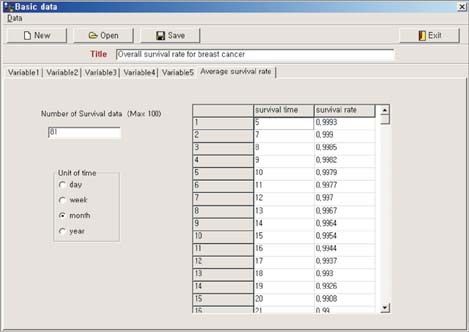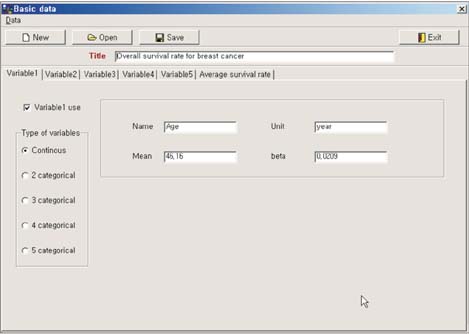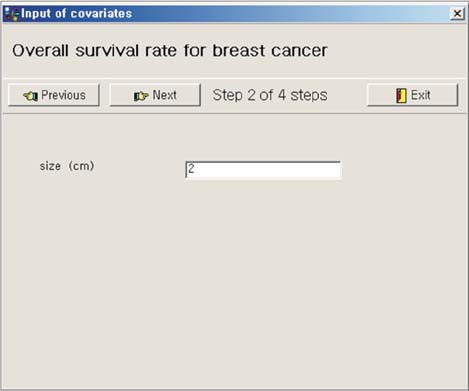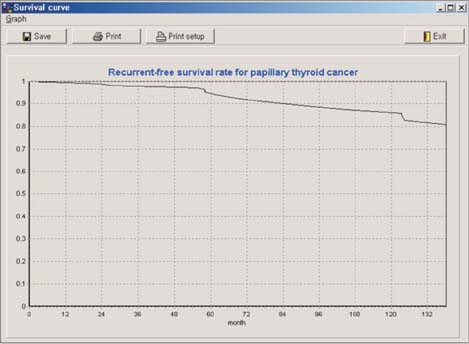Healthc Inform Res.
2015 Apr;21(2):134-137. 10.4258/hir.2015.21.2.134.
Development of Individual Survival Estimating Program for Cancer Patients' Management
- Affiliations
-
- 1Department of Surgery, Dankook University College of Medicine, Cheonan, Korea. changmc@dankook.ac.kr
- KMID: 2284617
- DOI: http://doi.org/10.4258/hir.2015.21.2.134
Abstract
OBJECTIVES
The goal of this report is to present an individual patient's survival estimation curve using the each institution's survival data after Cox proportional hazard analysis.
METHODS
The program was developed in three parts: input of basic data from Cox proportional hazard analysis, input of individual patient's covariates, and presentation of individual patient's survival curve. In the first part, the average survival rates with each survival time were entered as the means of covariates using the results of Cox proportional hazard analysis. In the second part, the individual patient's values of each covariate were entered for the calculation of survival estimation. In the third part, the survival curve was displayed according to the input data.
RESULTS
The data of 2,652 breast cancer patients were analyzed. Cox regression analysis was conducted using the covariates of age, tumor size, N stage, and M stage. The individual patient's survival curve was presented using the basic data and covariate factors. In the breast cancer patients, the program presented survival curves according to each patient's age, tumor size, N stage, and M stage. The data of 251 thyroid cancer patients were analyzed by a similar method.
CONCLUSIONS
We developed a program to present individual survival curves of cancer patients. This program will be useful for clinicians to assist their decision-making and discussion with patients.
Figure
Reference
-
1. Esik O, Tusnady G, Daubner K, Nemeth G, Fuzy M, Szentirmay Z. Survival chance in papillary thyroid cancer in Hungary: individual survival probability estimation using the Markov method. Radiother Oncol. 1997; 44(3):203–212.
Article2. Wang SJ, Wissel AR, Luh JY, Fuller CD, Kalpathy-Cramer J, Thomas CR Jr. An interactive tool for individualized estimation of conditional survival in rectal cancer. Ann Surg Oncol. 2011; 18(6):1547–1552.
Article3. Ravdin PM, Siminoff LA, Davis GJ, Mercer MB, Hewlett J, Gerson N, et al. Computer program to assist in making decisions about adjuvant therapy for women with early breast cancer. J Clin Oncol. 2001; 19(4):980–991.
Article4. Lee ET, Wang JW. Identification of prognostic factors related to survival time: Cox proportional hazards model. Statistical methods for survival data analysis. Hoboken (NJ): Wiley;2003. p. 298–338.5. Wishart GC, Azzato EM, Greenberg DC, Rashbass J, Kearins O, Lawrence G, et al. PREDICT: a new UK prognostic model that predicts survival following surgery for invasive breast cancer. Breast Cancer Res. 2010; 12(1):R1.
Article6. Lundin J, Lundin M, Isola J, Joensuu H. A web-based system for individualised survival estimation in breast cancer. BMJ. 2003; 326(7379):29.
Article7. Michaelson JS, Chen LL, Bush D, Fong A, Smith B, Younger J. Improved web-based calculators for predicting breast carcinoma outcomes. Breast Cancer Res Treat. 2011; 128(3):827–835.
Article8. Zhang X. Comparison of restricted mean survival times between treatments based on a stratified Cox model. Bio-Algorithms Med-Sys. 2013; 9(4):183–189.
Article9. Endo A, Takeo S, Tanaka H. predicting breast cancer survivability: comparison of five data mining techniques. J Korean Soc Med Inform. 2007; 13(2):177–180.
Article
- Full Text Links
- Actions
-
Cited
- CITED
-
- Close
- Share
- Similar articles
-
- Development of Individual Probabilities Estimating Program of Major Cancer in Koreans
- Introduction of Relative Survival Analysis Program: Using Sample of Cancer Registry Data with Stata Software
- Development and Evaluation of an App-Based Self-Management Program for Exercise Practice of Breast Cancer Survivors: A Non-Randomized Controlled Trial
- Development and Effects of a Mobile Application-based Self-Management Program for Chemotherapy-induced Peripheral Neuropathy in Colorectal Cancer Patients
- Development and Effects of a Health Care Empowerment Program for Patients Undergoing Hematopoietic Stem Cell Transplantation







